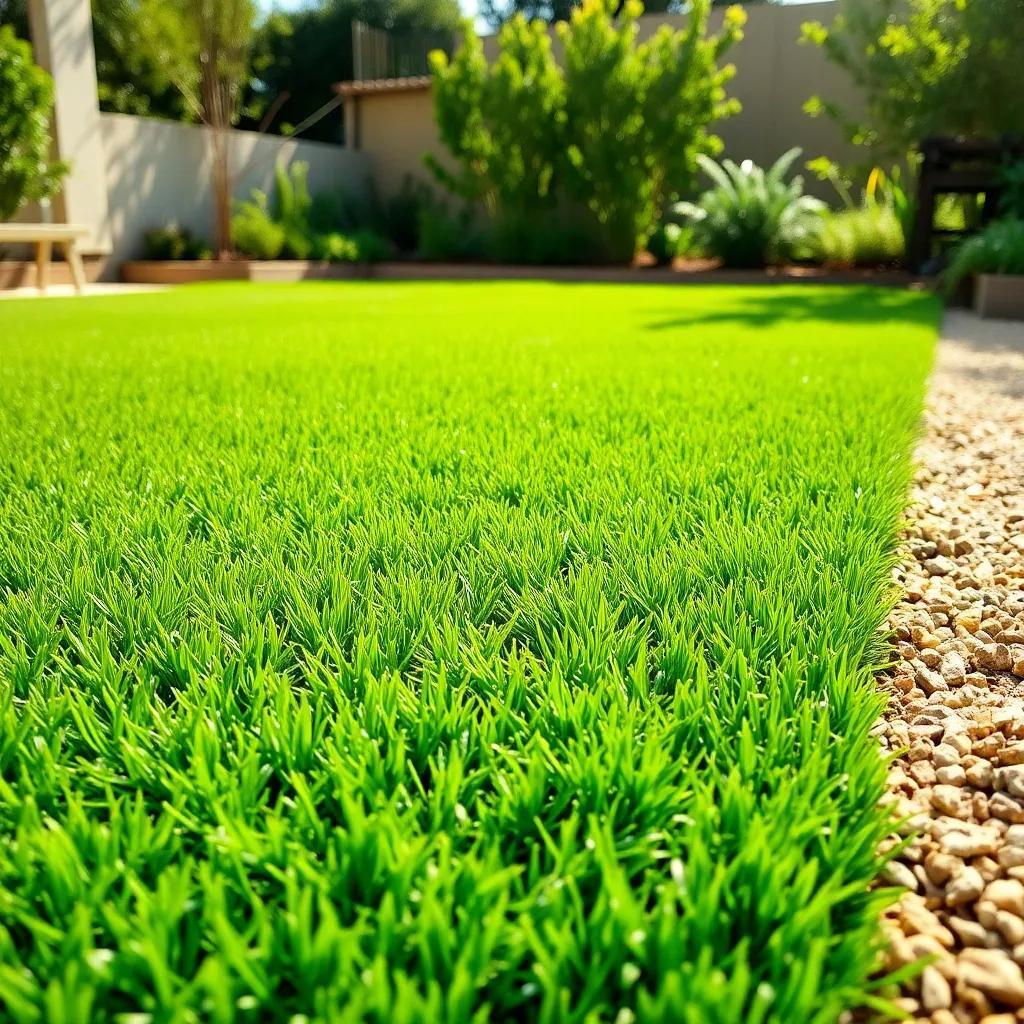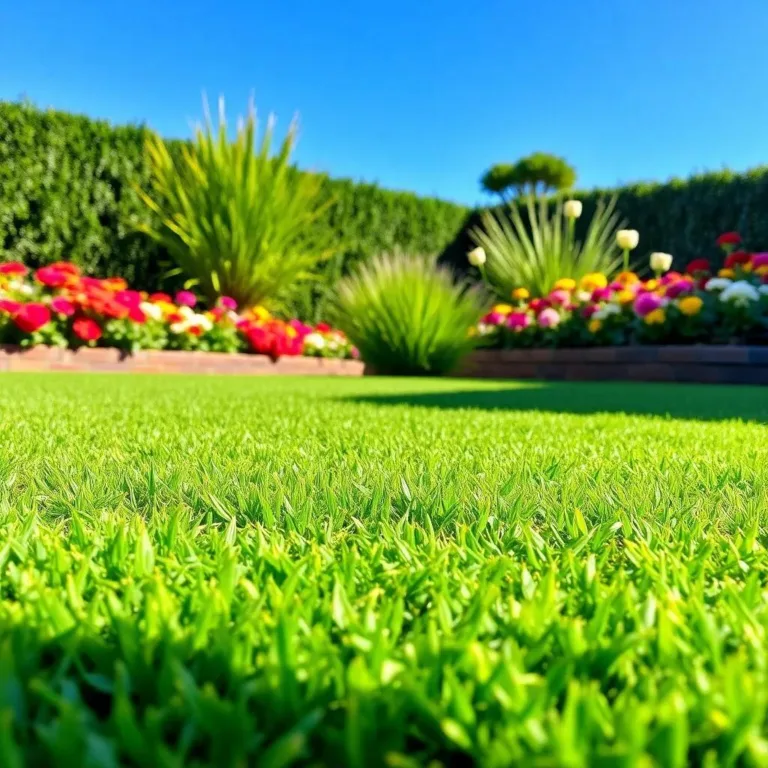Are you tired of mowing the lawn every weekend and dealing with pesky weeds? I totally get it! In this article, we’ll explore the amazing world of fake grass and how it can transform your outdoor space into a lush, green paradise with minimal effort. From understanding its composition to uncovering the environmental benefits and cost savings, you’ll discover why artificial turf might just be your new best friend!
Understanding the Composition of Fake Grass
When I think of fake grass, also known as artificial turf or synthetic grass, I can’t help but feel excited about how it mimics real grass so well! And the composition of this turf is fascinating. It’s made from a mix of synthetic materials that are carefully crafted to look and feel like the real deal. Here’s what goes into making that beautiful green carpet!
- Synthetic Blades: The blades of fake grass are usually made from polyethylene or polypropylene. These materials are super durable and can withstand a lot of wear and tear. They are designed to be soft to touch, yet tough enough to handle foot traffic without getting damaged. So yes, you can run and play on it without worrying!
- Backing Material: This is the part of fake grass that holds everything together! It’s made from a strong mesh material that’s often perforated, allowing for water drainage. This is key because nobody wants puddles on their lawn, right? The perforated backing helps prevent water from pooling and keeps your turf looking fantastic!
- Infill Material: To give fake grass a more natural feel, a layer of infill is added. This can be made from various materials, like silica sand or rubber granules. This infill stabilizes the blades and helps with drainage, making your lawn feel soft underfoot. It’s like having a comfy mat in your backyard!
- Environmental Considerations: I also love that many companies are moving towards more sustainable materials for fake grass. Some brands are using recycled products in their manufacturing, which means fewer resources are wasted. How cool is that?
So there you have it! The next time you step onto your lush fake grass, just remember all the science and design that makes it possible. It’s not just turf; it’s a carefully engineered masterpiece!
The Installation Process of Artificial Turf
Now that we’ve chatted about what fake grass is made of, let’s talk about how it gets from the store to your backyard! Installing fake grass might sound like a big task, but I promise it can be manageable and even fun! Here’s a simple breakdown of the installation process that will leave your yard looking fantastic!
- Preparation: Before the actual installation, you need to prepare your area. Clear out any weeds, rocks, and debris. If you have old grass, it might be best to remove it too. You want a clean slate! This way, your new lawn will have a strong foundation.
- Creating a Base: Next, you’ll want to lay down a base layer. This typically involves a mix of crushed stone or sand that helps with drainage. You’ll need to level this layer properly, so it’s smooth and even. Trust me, taking time here will pay off later!
- Measuring and Cutting: Once the base is ready, it’s time to measure and cut your fake grass. Make sure to leave a little extra around the edges. This is important for adjusting and securing the edges later on. Measuring twice and cutting once is my motto!
- Laying the Turf: After cutting, gently lay down the turf over the base. Make sure it looks nice and even. If you’ve got seams where two pieces meet, make sure to place them snugly together for a seamless look.
- Securing the Edges: Finally, you’ll want to secure the edges. This is where those extra pieces come in handy! Use stakes or adhesive, depending on your turf type, to keep everything in place. This will help your turf stay put even during storms or heavy playtime!
Once it’s all down, take a moment to admire your handiwork! Installing fake grass can be a great weekend project. Plus, you’ll end up with a cozy, vibrant lawn that needs much less care than natural grass. Now, isn’t that a win-win?

Key Maintenance Tips for Sustaining Fake Grass
Maintaining fake grass might seem like a chore, but trust me, it’s super easy and doesn’t take much time! I like to think of it as giving my lawn a little TLC every now and then! Here are some straightforward tips to keep your artificial turf looking fresh and fabulous:
- Regular Brushing: This is like giving your turf a nice comb! I like to use a stiff-bristled brush to keep the blades standing tall and proud. This helps prevent matting and ensures my lawn has that lush look. Just a quick brush every few weeks can do wonders!
- Debris Removal: Leaves, twigs, and other mess can make fake grass look less appealing. I recommend using a leaf blower or a handheld brush to tidy up. It’s like spring cleaning but for your lawn! Keeping it clear of debris not only looks good but also prevents odors and bacteria.
- Managing Pet Waste: If you have pets, like me, you know that accidents happen! It’s important to promptly pick up any mess and rinse the area with water to keep things clean and odor-free. Just make sure to steer clear of harsh chemicals; we want our furry friends safe!
- Stain Removal: Accidents can happen, and sometimes spills occur. If something gets on your turf, don’t panic! Just blot or rinse the area with mild soap and water. For tough stains, a little vinegar solution can work wonders. Always check the manufacturer’s guidelines before trying new cleaners!
- Seasonal Care: Keep an eye on your turf during different seasons. Rinsing it down during dry months helps wash away dust and pollen that can accumulate over time. It’s like giving your lawn a refreshing shower!
By following these easy maintenance tips, your fake grass can stay vibrant and inviting for years to come! It’s all about keeping it clean and looking its best, so you can enjoy a gorgeous, hassle-free lawn every day!
Environmental Benefits of Artificial Turf
When I think about fake grass, I often marvel at how it can help our environment! Yes, you heard me right! Artificial turf isn’t just a pretty face; it comes with some surprising environmental benefits that can make a positive impact. Let’s dig into a few of these advantages!
- Water Conservation: One of the biggest perks of fake grass is that it doesn’t need watering! This can save thousands of gallons of water each year! In areas where water is scarce, this is a game-changer. I love knowing that my lawn can stay green without draining precious resources!
- Reduced Chemical Use: Do you know how much a natural lawn needs fertilizers and pesticides to stay healthy? With fake grass, those toxic chemicals are out the window! This means healthier soil and cleaner waterways, which is something we can all feel good about. Plus, less chemical exposure means a safer place for our kids and pets to play!
- Lower Carbon Footprint: Think about all those times you’ve had to mow the lawn! With fake grass, lawnmowers are used a whole lot less. This helps cut down on air pollution and greenhouse gas emissions. My electric bill appreciates this too!
- Durability and Longevity: Artificial turf is designed to last! High-quality fake grass can keep its lush appearance for a decade or more. This means fewer lawn renovations and less waste going to landfills. The longer my turf lasts, the better it is for the planet!
- Eco-Friendly Materials: Many manufacturers are looking for ways to go green, using recycled materials in their products. This means that you can enjoy a beautiful lawn while supporting a more sustainable industry!
In short, adopting fake grass in your outdoor space can be a smart move for both your home and the environment. It’s a win-win situation that can help save water, reduce chemical usage, and create a greener planet!
Cost Analysis: Investing in Fake Grass
Now, let’s chat about the money side of things! I know, I know, talking about costs can feel a bit boring. But, trust me, understanding the cost analysis of fake grass is important when deciding if it’s the right choice for your home. Here’s the lowdown on what to expect!
- Initial Investment: Let’s be real—installing fake grass can come with a higher startup cost than simply sowing seeds. Depending on the size of your yard and the kind of turf you choose, the installation costs can vary. But don’t let that scare you! It’s an investment in convenience and beauty for your home.
- Long-Term Savings: Sure, the upfront costs may be higher, but consider this: you’re saving money on water bills since fake grass doesn’t require any watering! Talk about a joy for my wallet! Plus, the decrease in maintenance also means fewer supplies needed—goodbye lawnmowers and fertilizers!
- Minimal Maintenance Costs: Fake grass is all about low upkeep! Regular care, like brushing and cleaning, is easy and inexpensive. This means you won’t have to shell out much for lawn care services, which is a huge win if you want to keep your spending down.
- Durability Equals Longevity: High-quality artificial turf is made to last—typically around 10 to 20 years! This means fewer replacements and less hassle. You’ll be enjoying that beautiful lawn for years without worrying about replanting!
- Property Value Increase: A well-maintained lawn can actually boost your property value! Prospective buyers love the idea of a low-maintenance yard that looks stunning year-round. It’s like putting a cherry on top of your lovely home!
So while the initial investment in fake grass might feel hefty, consider all the long-term savings and benefits! In the end, you could find yourself with a beautiful lawn that’s easy to care for and boosts your property value—a smart choice for my budget!

